ECU GENESIS G90 2017 Owner's Manual
[x] Cancel search | Manufacturer: GENESIS, Model Year: 2017, Model line: G90, Model: GENESIS G90 2017Pages: 524, PDF Size: 19.3 MB
Page 7 of 524
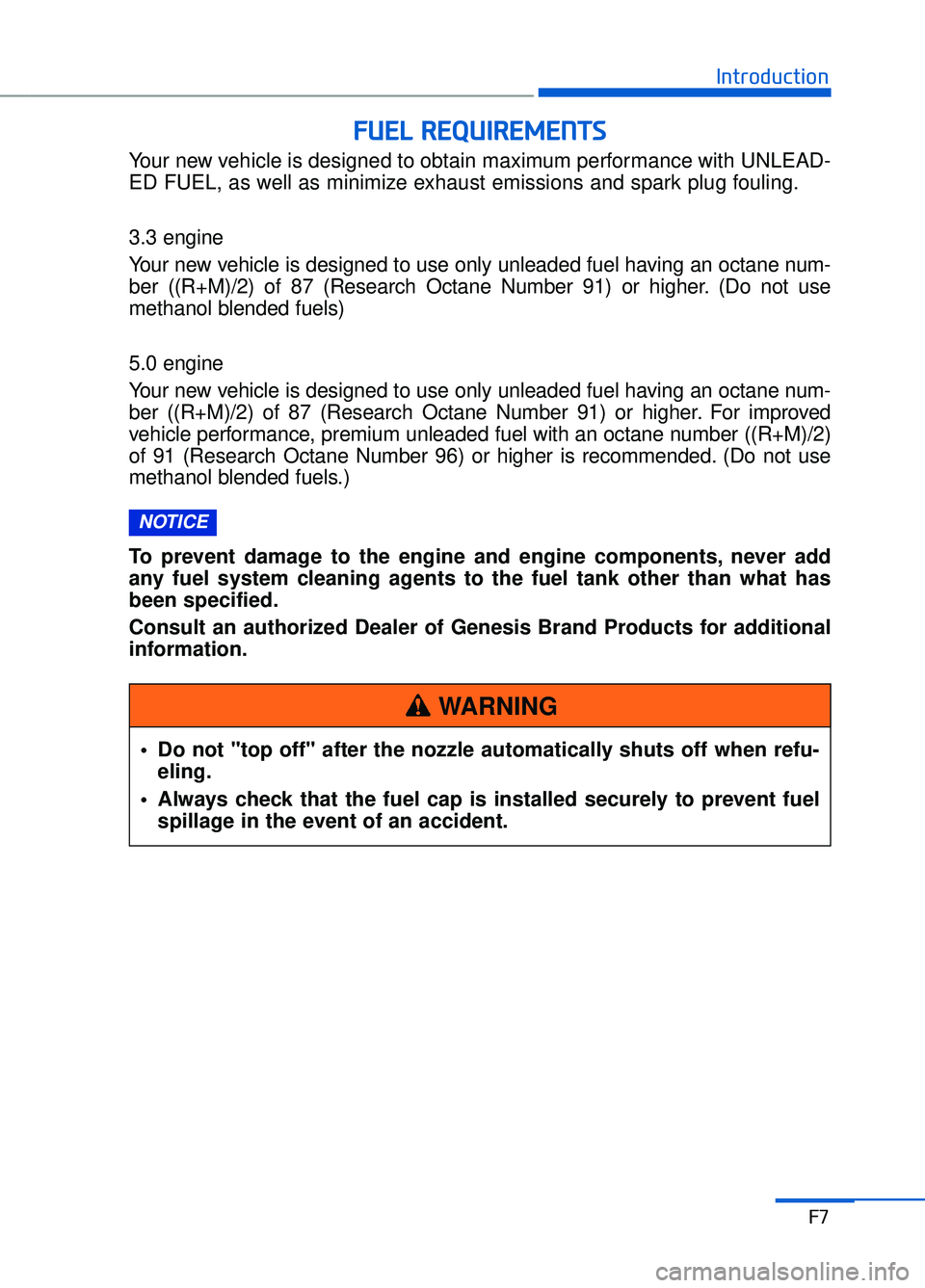
F
FU
U E
EL
L
R
R E
EQ
Q U
UI
IR
R E
EM
M E
EN
N T
TS
S
F7
Introduction
Your new vehicle is designed to obtain maximum performance with UNLEAD-
ED FUEL, as well as minimize exhaust emissions and spark plug fouling.
3.3 engine
Your new vehicle is designed to use only unleaded fuel having an octane num-
ber ((R+M)/2) of 87 (Research Octane Number 91) or higher. (Do not use
methanol blended fuels)
5.0 engine
Your new vehicle is designed to use only unleaded fuel having an octane num-
ber ((R+M)/2) of 87 (Research Octane Number 91) or higher. For improved
vehicle performance, premium unleaded fuel with an octane number ((R+M)/2)
of 91 (Research Octane Number 96) or higher is recommended. (Do not use
methanol blended fuels.)
To prevent damage to the engine and engine components, never add
any fuel system cleaning agents to the fuel tank other than what has
been specified.
Consult an authorized Dealer of Genesis Brand Products for additional
information.
NOTICE
• Do not "top off" after the nozzle automatically shuts off when refu-
eling.
Always check that the fuel cap is installed securely to prevent fuel spillage in the event of an accident.
WARNING
Page 42 of 524
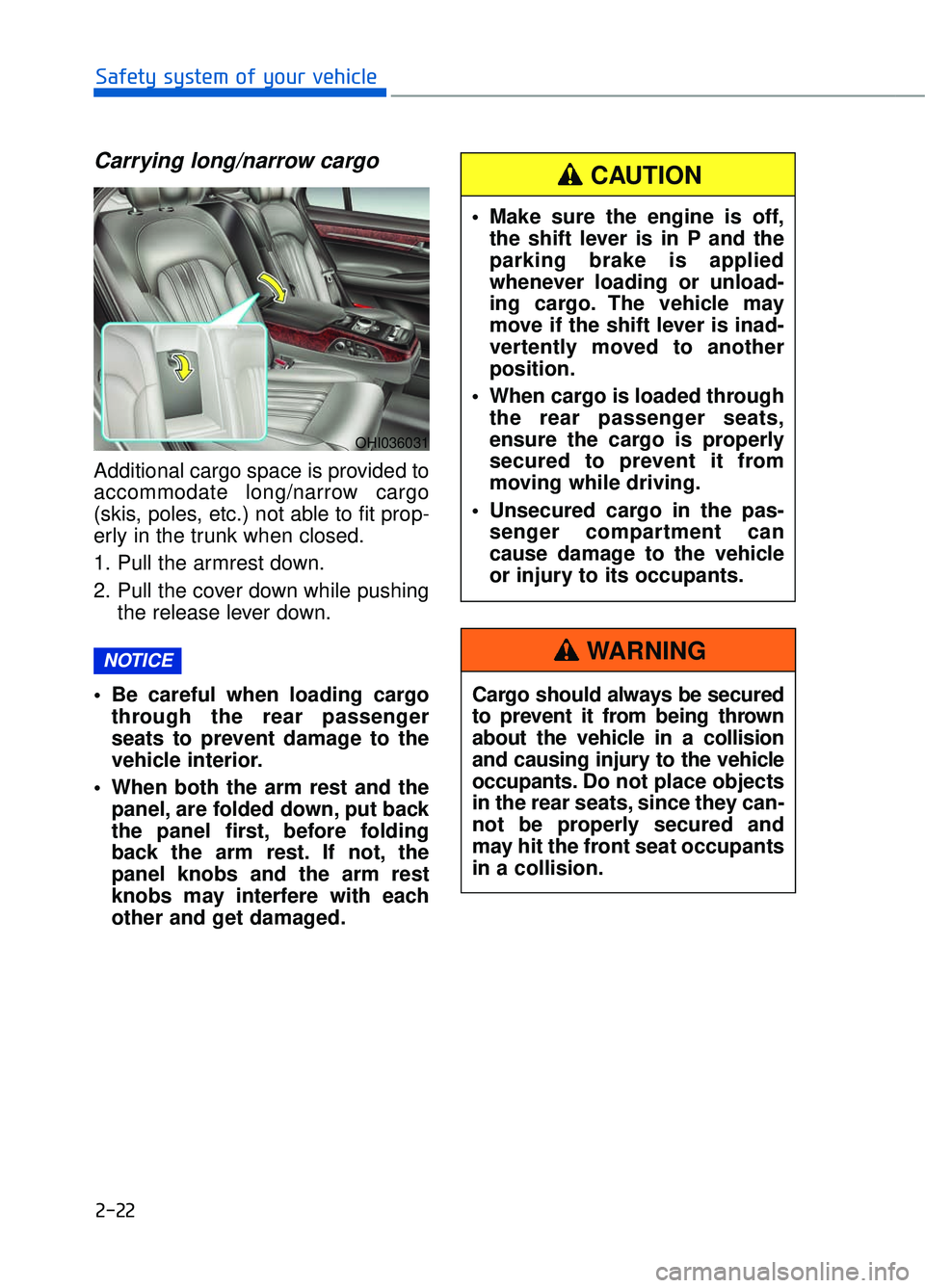
2-22
Safety system of your vehicle
Carrying long/narrow cargo
Additional cargo space is provided to
accommodate long/narrow cargo
(skis, poles, etc.) not able to fit prop-
erly in the trunk when closed.
1. Pull the armrest down.
2. Pull the cover down while pushingthe release lever down.
Be careful when loading cargo through the rear passenger
seats to prevent damage to the
vehicle interior.
When both the arm rest and the panel, are folded down, put back
the panel first, before folding
back the arm rest. If not, the
panel knobs and the arm rest
knobs may interfere with each
other and get damaged.
NOTICE
OHI036031
Cargo should always be secured
to prevent it from being thrown
about the vehicle in a collision
and causing injury to the vehicle
occupants. Do not place objects
in the rear seats, since they can-
not be properly secured and
may hit the front seat occupants
in a collision.
WARNING
Make sure the engine is off,the shift lever is in P and the
parking brake is applied
whenever loading or unload-
ing cargo. The vehicle may
move if the shift lever is inad-
vertently moved to another
position.
When cargo is loaded through the rear passenger seats,
ensure the cargo is properly
secured to prevent it from
moving while driving.
Unsecured cargo in the pas- senger compartment can
cause damage to the vehicle
or injury to its occupants.
CAUTION
Page 47 of 524

2-27
02
Pay extreme caution not to dam-
age the connectors, while remov-
ing the head restraint. Damage to
the connectors may cause a tech-
nical problem.
Folding the center head restraint
(if equipped)
To fold the center head restraint :
When the rear-center headrestraint is not used, manually fold
back the rear-center head restraint
while pressing the button (1) on the
side. To use the rear-center head
restraint again, manually pull up
the rear-center head restraint, until
it is securely latched.
You can remove the rear-center head restraint by manually pulling
up the rear-center head restraint,
while pressing the release button.
Information
You can adjust the rear-center head
restraint to the further lower height
by pressing the button (2), which is
located under the rear-center head
restraint, with the armrest folded
back. If the center head restraint is in
the lowest position, raise the head
restraint before folding back the
armrest.
NOTICE
i
NOTICE
OHI036130
When the center head restraint
is not in use, fold the head
restraint back to prevent it from
interfering with your vision
through the rear window.
CAUTION
Page 52 of 524
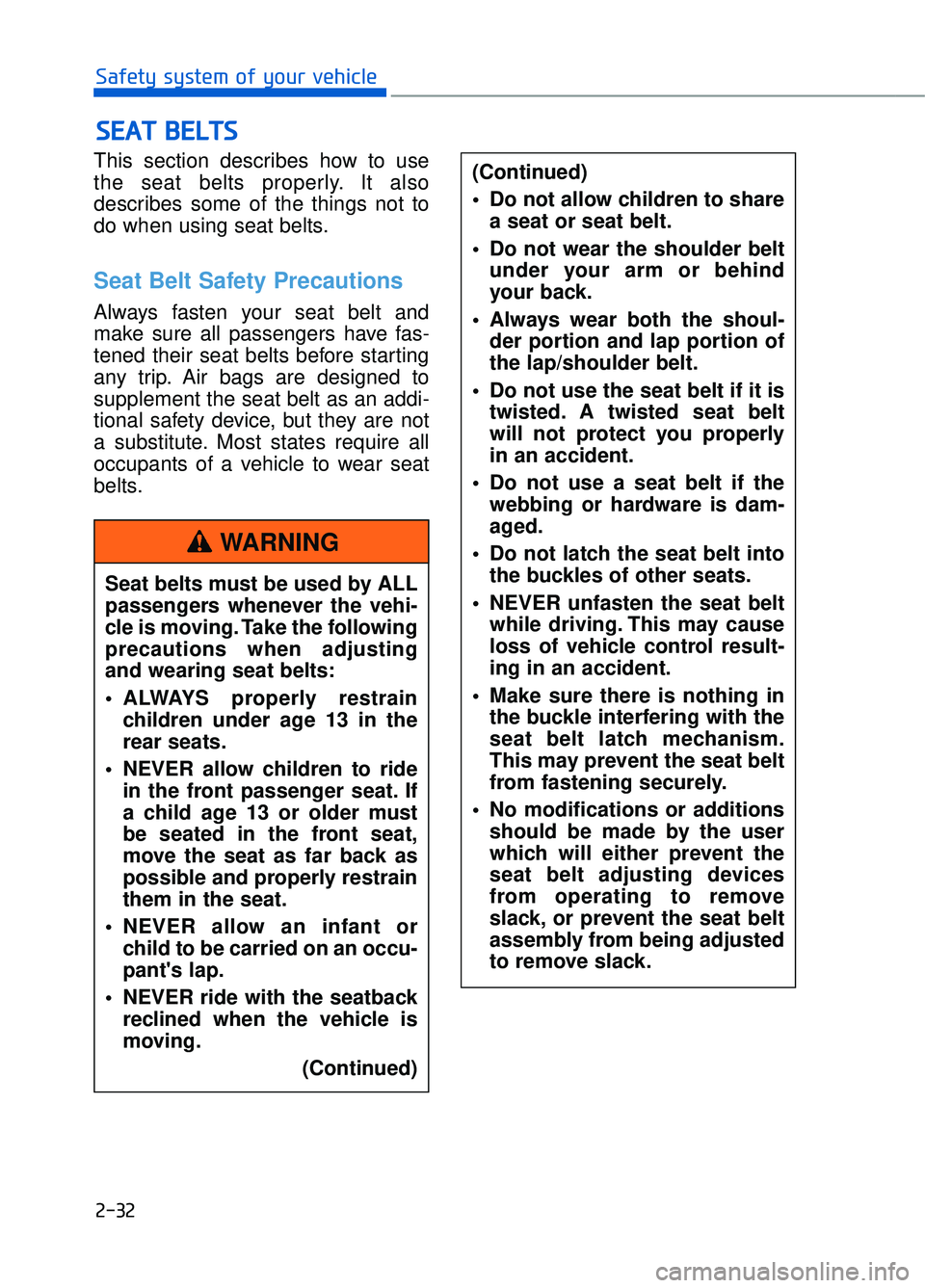
This section describes how to use
the seat belts properly. It also
describes some of the things not to
do when using seat belts.
Seat Belt Safety Precautions
Always fasten your seat belt and
make sure all passengers have fas-
tened their seat belts before starting
any trip. Air bags are designed to
supplement the seat belt as an addi-
tional safety device, but they are not
a substitute. Most states require all
occupants of a vehicle to wear seat
belts.
S SE
E A
A T
T
B
B E
EL
LT
T S
S
Seat belts must be used by ALL
passengers whenever the vehi-
cle is moving. Take the following
precautions when adjusting
and wearing seat belts:
ALWAYS properly restrain
children under age 13 in the
rear seats.
NEVER allow children to ride in the front passenger seat. If
a child age 13 or older must
be seated in the front seat,
move the seat as far back as
possible and properly restrain
them in the seat.
NEVER allow an infant or child to be carried on an occu-
pant's lap.
NEVER ride with the seatback reclined when the vehicle is
moving.
(Continued)
WARNING
2-32
Safety system of your vehicle
(Continued)
Do not allow children to sharea seat or seat belt.
Do not wear the shoulder belt under your arm or behind
your back.
Always wear both the shoul- der portion and lap portion of
the lap/shoulder belt.
Do not use the seat belt if it is twisted. A twisted seat belt
will not protect you properly
in an accident.
Do not use a seat belt if the webbing or hardware is dam-
aged.
Do not latch the seat belt into the buckles of other seats.
NEVER unfasten the seat belt while driving. This may cause
loss of vehicle control result-
ing in an accident.
Make sure there is nothing in the buckle interfering with the
seat belt latch mechanism.
This may prevent the seat belt
from fastening securely.
No modifications or additions should be made by the user
which will either prevent the
seat belt adjusting devices
from operating to remove
slack, or prevent the seat belt
assembly from being adjusted
to remove slack.
Page 56 of 524
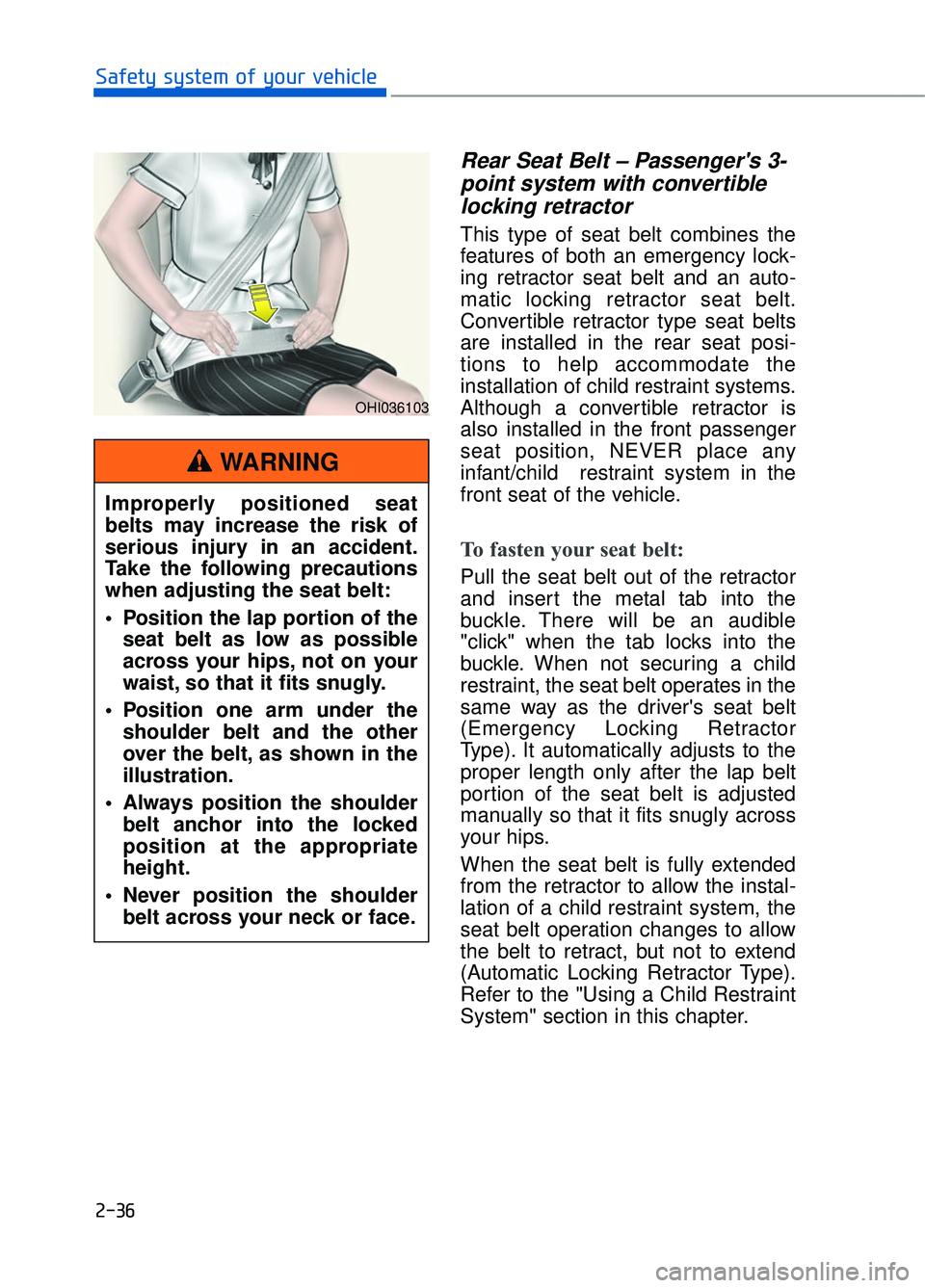
2-36
Safety system of your vehicle
Rear Seat Belt – Passenger's 3-point system with convertiblelocking retractor
This type of seat belt combines the
features of both an emergency lock-
ing retractor seat belt and an auto-
matic locking retractor seat belt.
Convertible retractor type seat belts
are installed in the rear seat posi-
tions to help accommodate the
installation of child restraint systems.
Although a convertible retractor is
also installed in the front passenger
seat position, NEVER place any
infant/child restraint system in the
front seat of the vehicle.
To fasten your seat belt:
Pull the seat belt out of the retractor
and insert the metal tab into the
buckle. There will be an audible
"click" when the tab locks into the
buckle. When not securing a child
restraint, the seat belt operates in the
same way as the driver's seat belt
(Emergency Locking Retractor
Type). It automatically adjusts to the
proper length only after the lap belt
portion of the seat belt is adjusted
manually so that it fits snugly across
your hips.
When the seat belt is fully extended
from the retractor to allow the instal-
lation of a child restraint system, the
seat belt operation changes to allow
the belt to retract, but not to extend
(Automatic Locking Retractor Type).
Refer to the "Using a Child Restraint
System" section in this chapter.
Improperly positioned seat
belts may increase the risk of
serious injury in an accident.
Take the following precautions
when adjusting the seat belt:
Position the lap portion of the
seat belt as low as possible
across your hips, not on your
waist, so that it fits snugly.
Position one arm under the shoulder belt and the other
over the belt, as shown in the
illustration.
Always position the shoulder belt anchor into the locked
position at the appropriate
height.
Never position the shoulder belt across your neck or face.
WARNING
OHI036103
Page 57 of 524

2-37
02
To release your seat belt:
Press the release button (1) in the
locking buckle.
When it is released, the belt should
automatically draw back into the
retractor. If this does not happen,
check the belt to be sure it is not twist-
ed, then try again.
Although the seat belt retractor
provides the same level of protec-
tion for seated passengers in
either emergency or automatic
locking modes, the emergency
locking mode allows seated pas-
sengers to move freely in their
seat while keeping some tension
on the belt. During a collision or
sudden stop, the retractor auto-
matically locks the belt to help
restrain your body.
To deactivate the automatic lock-
ing mode, unbuckle the seat belt
and allow the belt to fully retract.
Rear Center Seat Belt
1. Take out the buckle (2), which isstored between the seat/seatback
cushions.
2. Insert the metal plate (1) into the buckle (2), until it clicks.
You can make sure its secure fas- tening by pulling the seatbelt web-
bing. The buckle with 'CENTER'
mark should be used for the 3-
point seatbelt.
3. Restore the buckle between the seat/seatback cushion after unfas-
tening the seatbelt.
NOTICE
OHI036104
OHI036085
OHI036035
Page 63 of 524
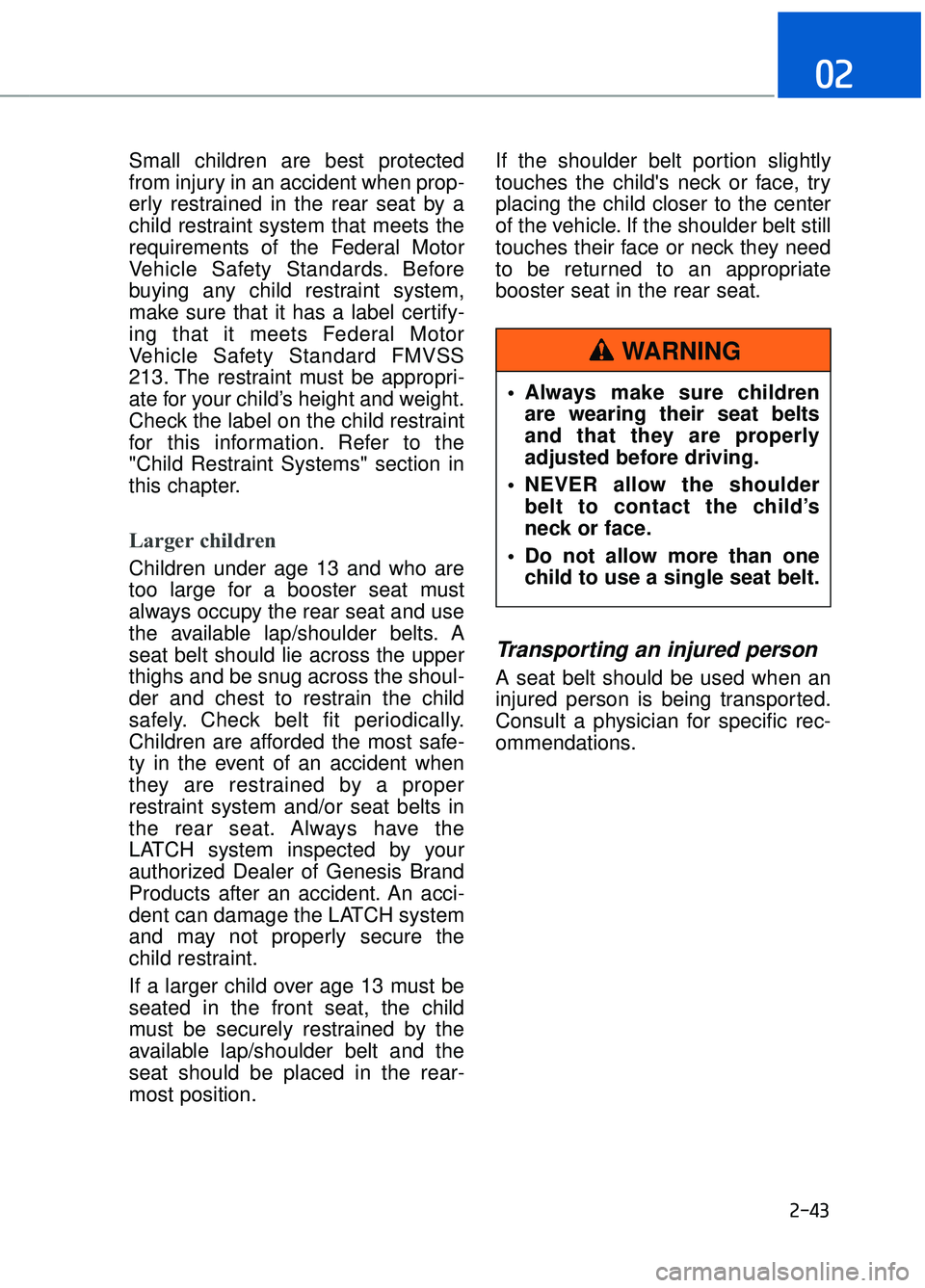
2-43
02
Small children are best protected
from injury in an accident when prop-
erly restrained in the rear seat by a
child restraint system that meets the
requirements of the Federal Motor
Vehicle Safety Standards. Before
buying any child restraint system,
make sure that it has a label certify-
ing that it meets Federal Motor
Vehicle Safety Standard FMVSS
213. The restraint must be appropri-
ate for your child’s height and weight.
Check the label on the child restraint
for this information. Refer to the
"Child Restraint Systems" section in
this chapter.
Larger children
Children under age 13 and who are
too large for a booster seat must
always occupy the rear seat and use
the available lap/shoulder belts. A
seat belt should lie across the upper
thighs and be snug across the shoul-
der and chest to restrain the child
safely. Check belt fit periodically.
Children are afforded the most safe-
ty in the event of an accident when
they are restrained by a proper
restraint system and/or seat belts in
the rear seat. Always have the
LATCH system inspected by your
authorized Dealer of Genesis Brand
Products after an accident. An acci-
dent can damage the LATCH system
and may not properly secure the
child restraint.
If a larger child over age 13 must be
seated in the front seat, the child
must be securely restrained by the
available lap/shoulder belt and the
seat should be placed in the rear-
most position.If the shoulder belt portion slightly
touches the child's neck or face, try
placing the child closer to the center
of the vehicle. If the shoulder belt still
touches their face or neck they need
to be returned to an appropriate
booster seat in the rear seat.
Transporting an injured person
A seat belt should be used when an
injured person is being transported.
Consult a physician for specific rec-
ommendations.
Always make sure children
are wearing their seat belts
and that they are properly
adjusted before driving.
NEVER allow the shoulder belt to contact the child’s
neck or face.
Do not allow more than one child to use a single seat belt.
WARNING
Page 65 of 524
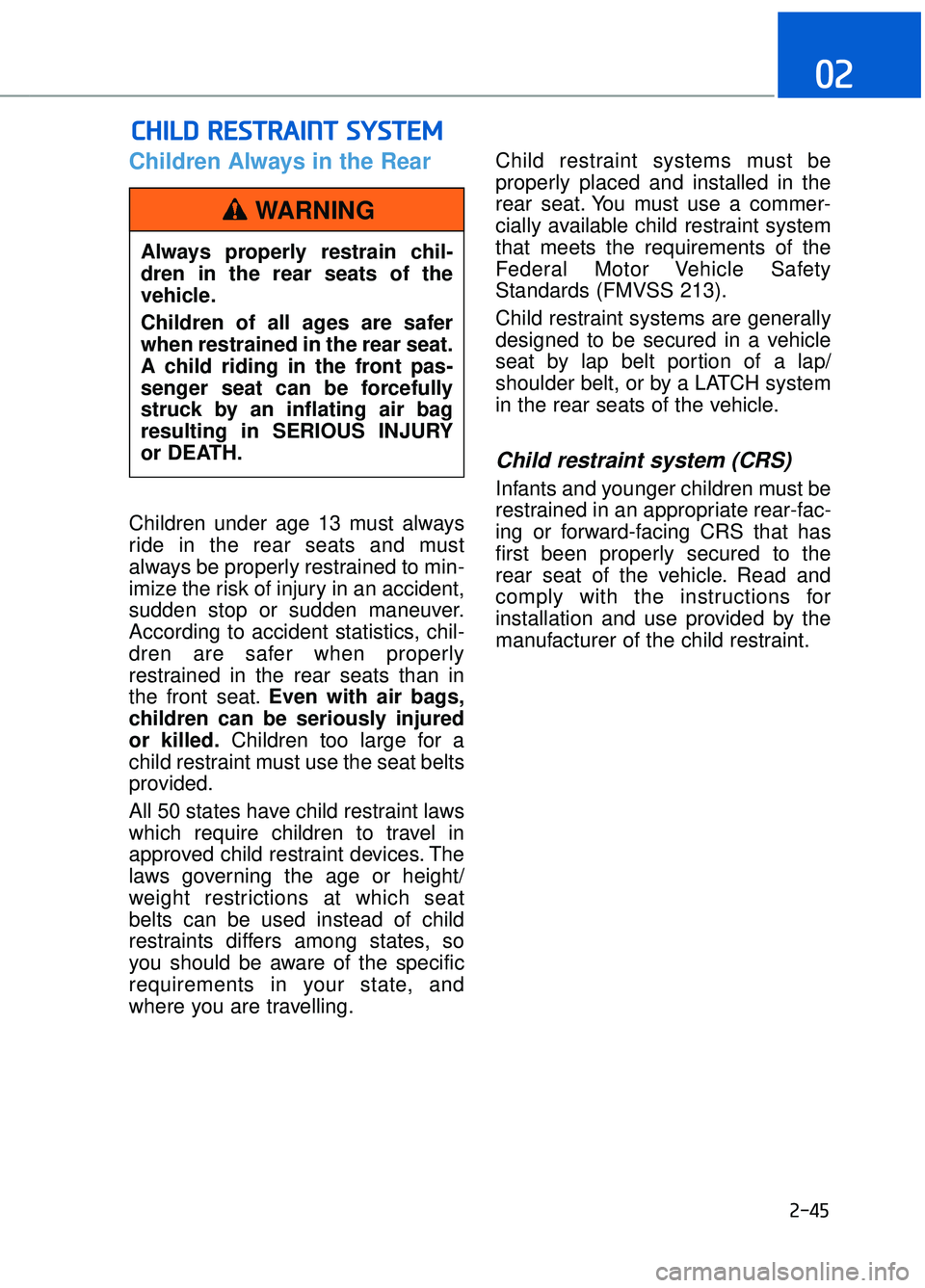
2-45
02
Children Always in the Rear
Children under age 13 must always
ride in the rear seats and must
always be properly restrained to min-
imize the risk of injury in an accident,
sudden stop or sudden maneuver.
According to accident statistics, chil-
dren are safer when properly
restrained in the rear seats than in
the front seat.Even with air bags,
children can be seriously injured
or killed. Children too large for a
child restraint must use the seat belts
provided.
All 50 states have child restraint laws
which require children to travel in
approved child restraint devices. The
laws governing the age or height/
weight restrictions at which seat
belts can be used instead of child
restraints differs among states, so
you should be aware of the specific
requirements in your state, and
where you are travelling. Child restraint systems must be
properly placed and installed in the
rear seat. You must use a commer-
cially available child restraint system
that meets the requirements of the
Federal Motor Vehicle Safety
Standards (FMVSS 213).
Child restraint systems are generally
designed to be secured in a vehicle
seat by lap belt portion of a lap/
shoulder belt, or by a LATCH system
in the rear seats of the vehicle.
Child restraint system (CRS)
Infants and younger children must be
restrained in an appropriate rear-fac-
ing or forward-facing CRS that has
first been properly secured to the
rear seat of the vehicle. Read and
comply with the instructions for
installation and use provided by the
manufacturer of the child restraint.
C C
H
H I
IL
L D
D
R
R E
ES
ST
T R
R A
A I
IN
N T
T
S
S Y
Y S
ST
T E
EM
M
Always properly restrain chil-
dren in the rear seats of the
vehicle.
Children of all ages are safer
when restrained in the rear seat.
A child riding in the front pas-
senger seat can be forcefully
struck by an inflating air bag
resulting in SERIOUS INJURY
or DEATH.
WARNING
Page 66 of 524
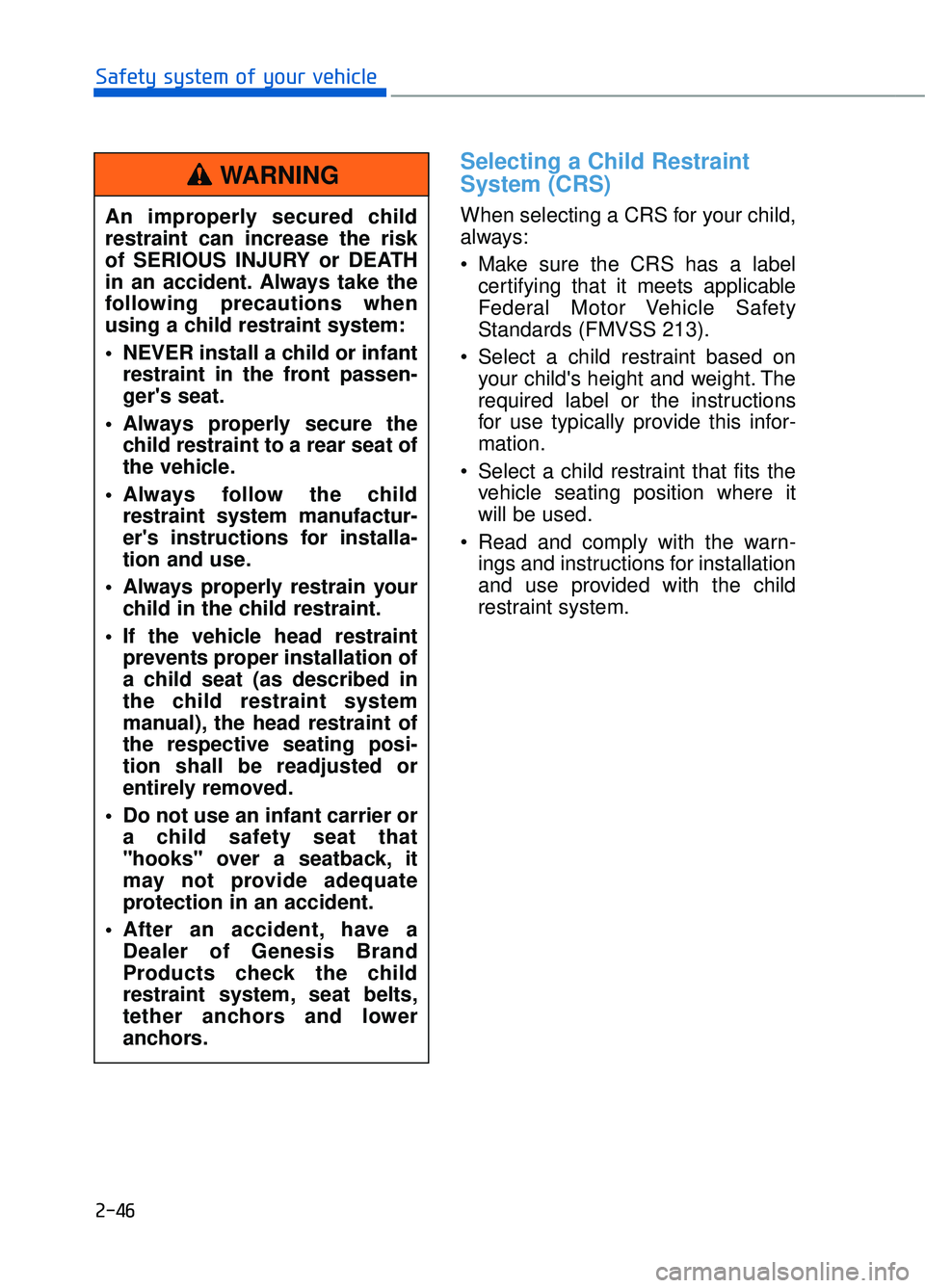
2-46
Safety system of your vehicle
Selecting a Child Restraint
System (CRS)
When selecting a CRS for your child,
always:
Make sure the CRS has a labelcertifying that it meets applicable
Federal Motor Vehicle Safety
Standards (FMVSS 213).
Select a child restraint based on your child's height and weight. The
required label or the instructions
for use typically provide this infor-
mation.
Select a child restraint that fits the vehicle seating position where it
will be used.
Read and comply with the warn- ings and instructions for installation
and use provided with the child
restraint system.
An improperly secured child
restraint can increase the risk
of SERIOUS INJURY or DEATH
in an accident. Always take the
following precautions when
using a child restraint system:
NEVER install a child or infant
restraint in the front passen-
ger's seat.
Always properly secure the child restraint to a rear seat of
the vehicle.
Always follow the child restraint system manufactur-
er's instructions for installa-
tion and use.
Always properly restrain your child in the child restraint.
If the vehicle head restraint prevents proper installation of
a child seat (as described in
the child restraint system
manual), the head restraint of
the respective seating posi-
tion shall be readjusted or
entirely removed.
Do not use an infant carrier or a child safety seat that
"hooks" over a seatback, it
may not provide adequate
protection in an accident.
After an accident, have a Dealer of Genesis Brand
Products check the child
restraint system, seat belts,
tether anchors and lower
anchors.
WARNING
Page 68 of 524
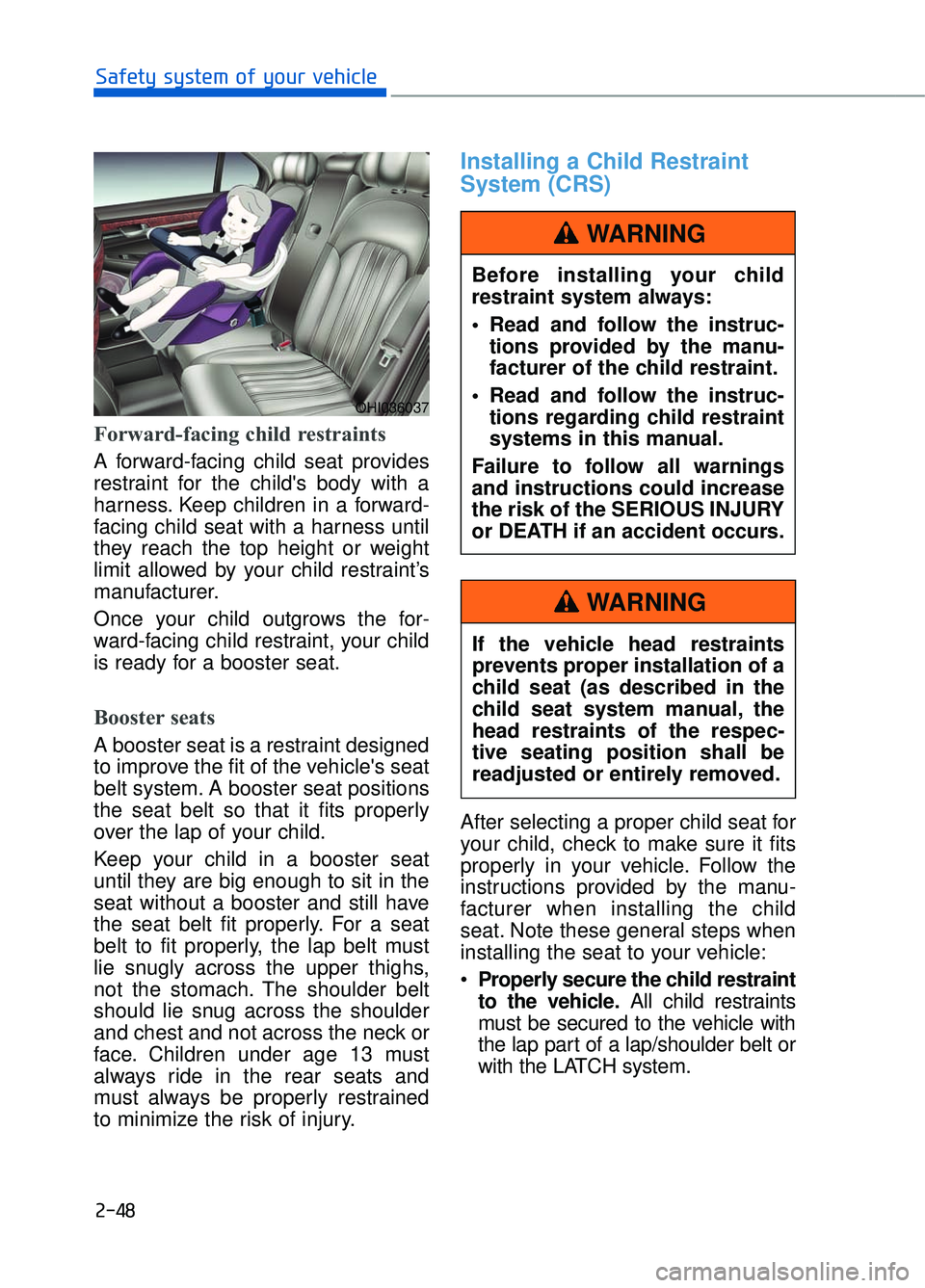
2-48
Safety system of your vehicle
Forward-facing child restraints
A forward-facing child seat provides
restraint for the child's body with a
harness. Keep children in a forward-
facing child seat with a harness until
they reach the top height or weight
limit allowed by your child restraint’s
manufacturer.
Once your child outgrows the for-
ward-facing child restraint, your child
is ready for a booster seat.
Booster seats
A booster seat is a restraint designed
to improve the fit of the vehicle's seat
belt system. A booster seat positions
the seat belt so that it fits properly
over the lap of your child.
Keep your child in a booster seat
until they are big enough to sit in the
seat without a booster and still have
the seat belt fit properly. For a seat
belt to fit properly, the lap belt must
lie snugly across the upper thighs,
not the stomach. The shoulder belt
should lie snug across the shoulder
and chest and not across the neck or
face. Children under age 13 must
always ride in the rear seats and
must always be properly restrained
to minimize the risk of injury.
Installing a Child Restraint
System (CRS)
After selecting a proper child seat for
your child, check to make sure it fits
properly in your vehicle. Follow the
instructions provided by the manu-
facturer when installing the child
seat. Note these general steps when
installing the seat to your vehicle:
Properly secure the child restraint
to the vehicle.
All child restraints
must be secured to the vehicle with
the lap part of a lap/shoulder belt or
with the LATCH system.
OHI036037
Before installing your child
restraint system always:
Read and follow the instruc- tions provided by the manu-
facturer of the child restraint.
Read and follow the instruc- tions regarding child restraint
systems in this manual.
Failure to follow all warnings
and instructions could increase
the risk of the SERIOUS INJURY
or DEATH if an accident occurs.
WARNING
If the vehicle head restraints
prevents proper installation of a
child seat (as described in the
child seat system manual, the
head restraints of the respec-
tive seating position shall be
readjusted or entirely removed.
WARNING